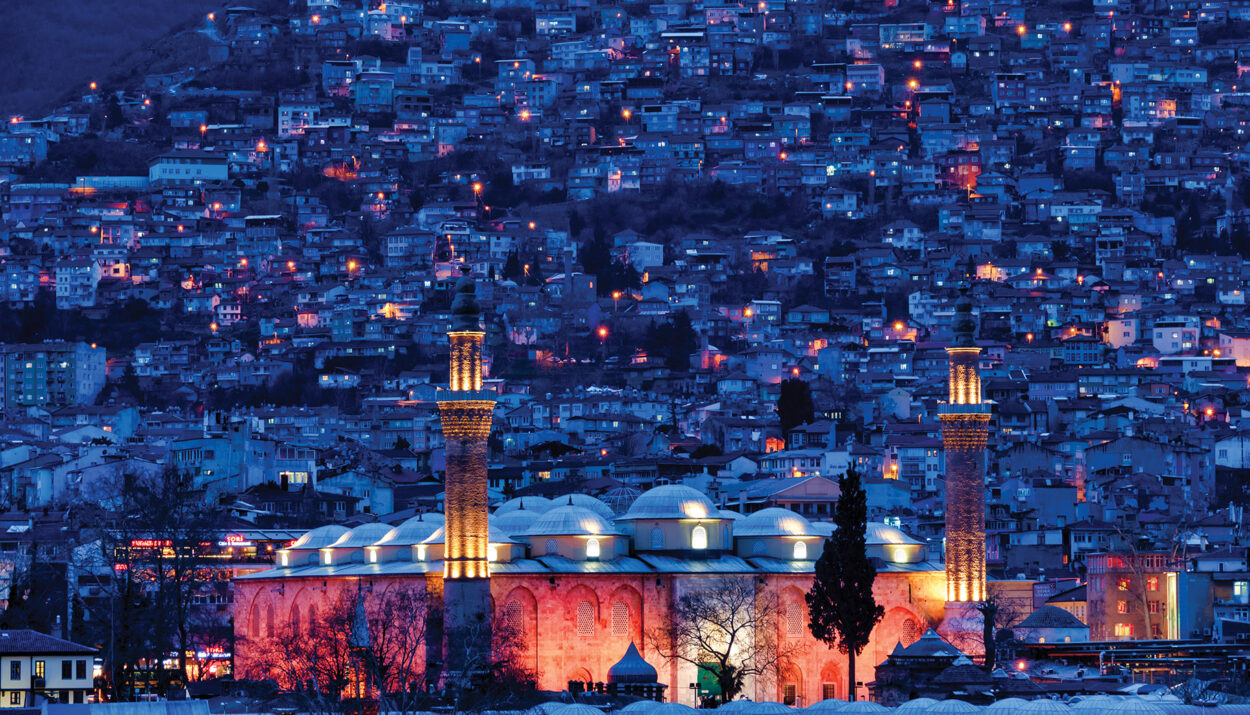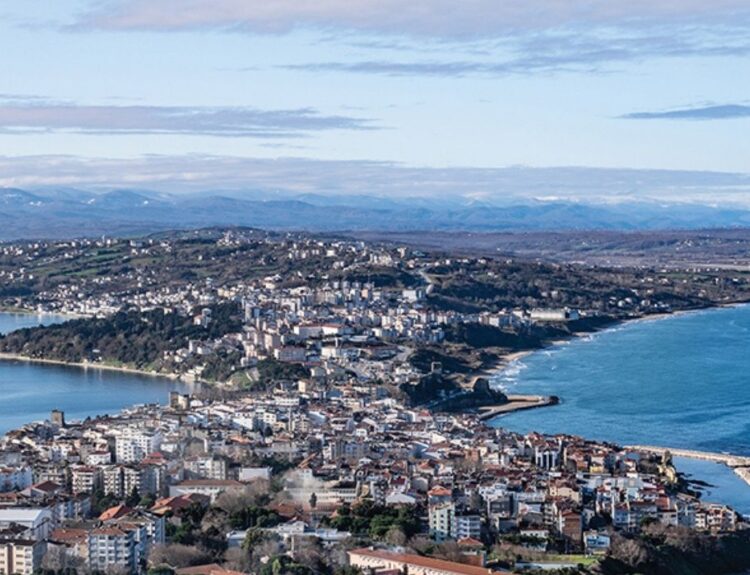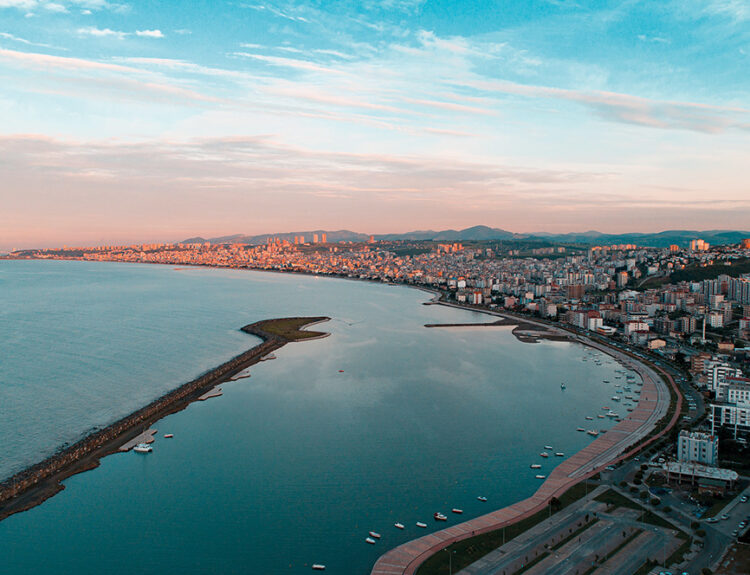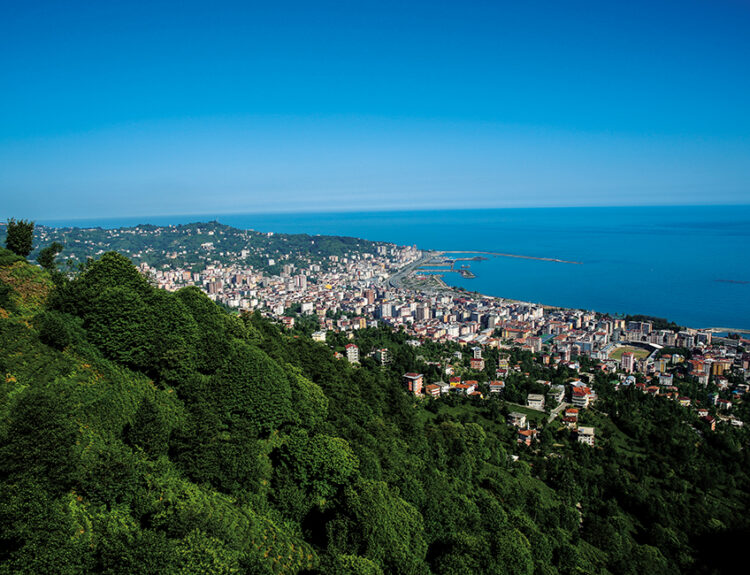Bursa, the first capital of the Ottoman Empire, presents a unique experience to its visitors through the traces of the past such as the historic mosques, caravanserais, and complexes (külliye) combined with the dynamism and liveliness of modern life. The city, one of Türkiye’s most important industrial and commercial centers, stands out with its strong industrial infrastructure in sectors such as automotive, textiles, and machinery. In this unique city, the patterns from the depths of history await to be discovered alongside the modern industrial and commercial life of today.
Located on the shores of the Sea of Marmara, at the foothills of green mountains, Bursa is a historic city founded in 202 BC by King Prusias I of Bithynia and it was named “Prusa” after its founder. Prusa, which became one of the important cities of the Bithynian Kingdom, was strategically positioned at the time it was founded. The city was located at the crossroads of trade routes, which led to the city quickly becoming an important commercial hub. Prusa’s economy was based on agriculture, trade, and crafts. The city produced and sold products such as olive oil, wine, and grain.
When the Kingdom of Bithynia joined the Roman Empire in 74 BC, Prusa also came under Roman rule. During this period, the city was enriched with Roman culture and architecture, developed an advanced city planning, and saw the construction of significant public buildings, theaters, baths, and temples. During the Roman period, Prusa began to be referred to as “Prusa ad Olympum.” This name referred to the nearby Uludağ (Olympos). During the Roman period, the city continued to be an important center both commercially and culturally.
The city came under Ottoman rule in 1326
Centuries passed, and the rise and fall of the Roman Empire, the grandeur of the Byzantine Empire, and the immense power of the Ottoman Empire shaped the fate of Bursa. Conquered by Orhan Gazi, the son of Osman Gazi, in 1326, Bursa became the first capital of the Ottoman Empire. During this period, the city was adorned with mosques, madrasas, hammams, and inns constructed by Ottoman sultans and viziers.
It was highly renowned for silk production and trade
During this period, Bursa was highly renowned for silk production and trade. As one of the key stops on the Silk Road, Bursa became particularly known for sericulture and silk production. This greatly contributed to the city’s economic development. Additionally, the inns, bedesten (a type of covered bazaar), and covered bazaars established in Bursa invigorated the city’s commercial life.
With the Republic, industrialization gained momentum
With the establishment of the Republic of Türkiye in 1923, Bursa became one of the key cities where new governance and reforms were implemented. During the Republic era, Bursa’s economic and social structure underwent significant changes. During this period, industrialization gained momentum. Bursa made significant progress, especially in the textile and automotive sectors. From the 1960s onwards, numerous factories and industrial facilities were established in Bursa, making it one of Türkiye’s most important industrial cities. During the Republic period, significant investments were also made in education and healthcare in Bursa. Many schools, universities, and hospitals were established in the city. Bursa Uludağ University was founded in 1975 and quickly became one of Türkiye’s leading universities. During the Republic period, tourism also became an important sector for Bursa. Uludağ emerged as a major center for winter sports and nature tourism. Additionally, with its rich historical and cultural heritage, Bursa continued to attract both domestic and international tourists. The city’s historic bazaars, mosques, and other architectural landmarks, some of which are included in the UNESCO World Heritage List, have significantly boosted its tourism potential.
Bursa’s Hagia Sophia: The Grand Mosque
Described as “Bursa’s Hagia Sophia, the grandest of all mosques” in Evliya Çelebi’s Travel Diary, The Grand Mosque is one of the most exceptional examples of early Ottoman architecture, and it is the largest mosque in Türkiye in terms of enclosed prayer space.
The last complex built by the Ottoman sultans
Muradiye Complex, one of the sites in Bursa that bears the traces of history, is the last complex built by the Ottoman sultans. It was commissioned by Sultan Murad II between 1425 and 1426 and the district where the complex is located was named after it. The complex includes a mosque, bathhouse, madrasa, imaret, and 12 tombs that were added to its garden in later years.
Koza Han with 95 Rooms
Built in 1491 by Bayezid II to provide income for the mosque and madrasa in Istanbul, Koza Han is situated in a large area between Gazi Orhan Mosque and the Grand Mosque. The han, constructed mainly from cut stone with occasional use of brick, has a total of 95 rooms: 50 on the upper floor and 45 on the lower floor.
Cumalıkızık, one of the first areas settled by the Ottomans in Bursa, is a unique location that preserves the Ottoman residential architecture with a total of 270 houses, 180 of which are still in use and some of which are undergoing preservation and restoration work.
Do not leave before you…
See Cumalıkızık, one of the last Ottoman villages,
Explore Gölyazı Village and Tirilye,
Ski at Uludağ,
Visit the complexes,
Experience the hot springs,
See the İnkaya Plane Tree, which is Türkiye’s oldest tree with its 595-year long history,
Visit Türkiye’s first and only Karagöz Museum,
Visit the Grand Mosque and the Green Tomb,
Drink Turkish coffee at Koza Han,
Eat İskender kebab, Kemalpaşa dessert
and candied chestnut,
Buy İznik pottery, Bursa knife, Bursa silk and towel…
Uludağ and ski tourism
Uludağ, an internationally recognized ski resort, and ski tourism make significant contributions to Bursa’s social and cultural life. International festivals, ski races, and various events enhance cultural diversity in the city and encourage interaction between locals and tourists. These events help shape Bursa’s image as a vibrant and dynamic city. The revenue from tourism supports the development of infrastructure and services in Bursa, improving the quality of roads, accommodation facilities, restaurants, and entertainment venues.
One of Türkiye’s most important industrial and commercial centers
Bursa is one of Türkiye’s most important industrial and commercial centers, and its economy, notable for its economic diversity, stands out with its strong industrial infrastructure, trade activities, agricultural production, tourism potential, and developed infrastructure and logistics capabilities. The automotive sector is the backbone of the city’s economy. Major automobile factories such as Tofaş, Renault, and Karsan are located in Bursa. Additionally, the city is also a significant hub in the automotive side industries. The textile and apparel sector continues Bursa’s historical silk production legacy and remains a major economic activity today. Additionally, the machinery and metalworking industry is well-developed in the city and constitutes a significant portion of industrial production. The agriculture and food sector also holds a significant place in Bursa’s economy. Thanks to its fertile agricultural lands and temperate climate, the city excels in fruit and vegetable production. Products such as peaches, cherries, pears, and olives are particularly abundantly grown in Bursa.
What to eat and drink?
With its fertile lands and favorable climate, Bursa’s cuisine is also highly developed in line with its agricultural richness. Although Bursa cuisine primarily represents Ottoman cuisine, it has also been enriched by the various cultures that have lived there. Among Bursa’s most famous and well-known dishes are the world-renowned İskender Kebab, İnegöl Meatballs, and Meatballs with Pide. In addition to Bursa’s famous Kemalpaşa Dessert, Candied Chestnut and Mihaliç Cheese, it also has popular soups such as Şipşi and Oğmaç. Other dishes you can try out from the traditional Bursa cuisine, originating from the Ottoman Palace cuisine include dik dik kebab, etli erik (plums with meat), cantık pide, kebab with aubergine puree, and walnut Turkish delight. Drinks associated with Bursa include boza, the cold-weather beverage, and sherbet, the drink for hot summer days. Both boza and sherbet are among the flavors that have deep historic roots in Bursa.




